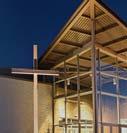


Jesus says we add flavor and season the world when we prioritize healthy relationships with other disciples.




Jesus says we add flavor and season the world when we prioritize healthy relationships with other disciples.
We season the world when we prioritize peace
Whilemaking a cheesecake for Valentine’s Day, I was surprised that the recipe called for 1/8 teaspoon of salt. Why salt, since it was such a small amount, I wondered. So, I did what we do when we have an odd question—I googled it. According to Baker Bettie’s website: “Baked goods made without salt will taste flat and boring. Salt enhances and balances flavors, especially sweetness. The proper amount of salt can take a mediocre recipe and make it outstanding.”
Salt’s crucial contribution to food may be why Jesus says his disciples are the “salt of the earth” (Matt. 5:13). But Jesus also warns that salt can lose its saltiness. “Salt is good for seasoning. But if it loses its flavor, how do you make it salty again? You must have the qualities of salt among yourselves and live in peace with each other” (Mark 9:50, NLT).
How can salt become not salty? Thanks to another Google search I learned that while salt is a very stable substance and doesn’t lose its saltiness, additives do cause salt to lose its flavor. One thing Jesus cautions his followers to avoid is discord. Jesus says we add flavor and season the world when we prioritize healthy relationships with other disciples. That’s easier said than done. One commentator suggests the ancient salt vow can help us better understand these verses. If two people shared salt, they were bound to defend and support each other, even if they had been enemies. So, Jesus’ disciples should live out a similar commitment to each other.
A group of USMB pastors and ministry leaders had the opportunity to “share salt” as they listened to and heard from each other during the January vision summit on leadership development. Toward the end of the summit, one participant alluded to this quote from business author John Kador, “You don’t have to see eye-to-eye to walk hand-inhand. You just have to want to go in the same direction.” In this situation the same direction was calling and equipping more pastors, church planters and missionaries.
When I think about our faith community, I know U.S. Mennonite Brethren are not going to agree with each other all the time and I doubt that we’re going to quickly change one another’s minds about how we view issues of the day. But we can join hands and commit to listening to one another and hearing each other out. We can give one another grace along with a pinch of salt.
This issue of Christian Leader offers a taste of USMB Gathering 2024, the National Pastors’ Conference and Delegate Convention scheduled for July 23-27 in Omaha, Neb., around the theme of “Salt & Light: Faithful living in a secular culture.” Feature articles and BodyLife stories shine a light on the theme, business agenda and speakers as well as the four USMB congregations in Omaha. We don’t want readers to be in the dark about this biennial event.
Connie Faber, Editor

Publisher: United States Conference of Mennonite Brethren Churches/ISSN 0009-5149
Editorial Committee: Matt Ehresman, Michele Fiester, Aaron Garza, Ryan Loewen, Shelly Spencer, Tony Petersen.
Review Committee: Don Morris, Jordan Ringhofer, Brent Warkentin, Daniel Rodriguez
Postmaster: Send address changes to Christian Leader, Box 155, Hillsboro, KS 67063. Periodical postage paid at Hillsboro, KS Vol. 87, No. 2 — March/April 2024
Disclaimer: The content and viewpoints expressed do not necessarily reflect the views, beliefs and/or viewpoints of USMB as a whole.
Copyright: Articles are owned by the Christian Leader or the author and may not be reprinted without permission. Unless noted, Scripture quotations are from the New International Version.
Subscriptions: $10 for six issues and $20 for 12 issues ($15, $30 in Canada, all other countries $25 for six issues); $2 per copy.
Correspondence: Christian Leader, Box 155, 107 N. Main, Hillsboro, KS 67063-0155. Phone: 620.947.5543. Email: editor@usmb.org
Membership: Evangelical Press Association and Meetinghouse
■ Don Morris, EDITOR-IN-CHIEF
■ Connie Faber, EDITOR
■ Janae Rempel Shafer, ASSOCIATE EDITOR
■ Shelley Plett, GRAPHIC DESIGNER






AlthoughI have written about abortion and the sanctity of life in the past, I have been asked by several people to clearly address this important issue from my perspective as the national director.
Our USMB Confession of Faith Article 14 states, in part, “because God is creator, the author and giver of life, we oppose all actions and attitudes which devalue human life…God values human life highly. Ultimate decisions regarding life and death belong to God. Therefore, we hold that procedures designed to take life, including abortion, euthanasia and assisted suicide, are an affront to God’s sovereignty.”
This is what we collectively believe. This is what I believe.
Let’s openly talk and preach in our churches about the value of life.
David’s well-known statement in Psalm 139 says we are made by God: “For you (God) created my inmost being; you knit me together in my mother’s womb. I praise you because I am fearfully and wonderfully made.”
Although sanctity of life covers more than abortion, because 99 percent of abortions are elective or do not involve saving the life of the mother, this article focuses on abortion.
Pro-choice advocates call abortion a “woman’s health issue” and “a fundamental right.” They say it’s a choice for a woman to make. I am going to be extremely blunt. This “choice” is the murder of a baby, even if it occurs within the first day of the first trimester of pregnancy. Unless it’s done through chemical abortion in early pregnancy, an abortion often involves ripping babies apart until they are dead. Is that a “choice” we as believers can even remotely entertain as being legitimate? May it never be!
According to multiple sources, over 65 million babies in the U.S. alone have had their lives snuffed out since 1973. I often wonder what these individuals might have accomplished for the good of mankind—good that we will never know about. They were created by God with unique abilities, characteristics and value. But their lives were deemed erasable.
As followers of Jesus, in a way we have become almost numb to the realities of what we’re really talking about here. The horrific realities of elective abortion should cause us to consistently seek to eradicate this afront to the Creator.
According to Seth Gruber, national advocate for the unborn, “91 percent of church goers today listed abortion as the most important topic to be heard from their pastors.” But we don’t talk about it much. And I am as guilty of this as anyone.
Gruber continues, “The abortion industrial arena with liberal media and politicians invests almost unlimited resources annually, promoting, protecting and facilitating the murder of unborn babies in the womb on demand…yet, (the majority) of churches have zero pro-life expression.”
As churches and followers of Jesus, let’s be immeasurably sensitive and loving to those who have chosen abortion in the past and may even be dealing with deep pain. Let’s be there for them, walking with them, openly listening. Some are dealing with hidden pain and remorse. If that’s you, you are forgiven. You are loved by God!
I write this not just to clarify my position or our MB position. I write this to call us to action as a family of churches. Even though the Supreme Court over-turned Roe v. Wade in 2022, many states still provide for abortion. Taking of innocent lives is still occurring.
Let’s support efforts to provide care and resources for mothers and fathers who are choosing life. Let’s actively support Christian adoption centers and pregnancy care centers. Let’s unreservedly advocate for the unborn in our spheres of influence. Let’s openly talk and preach in our churches about the value of life.
Don Morris don@usmb.org



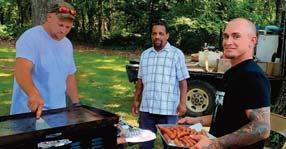

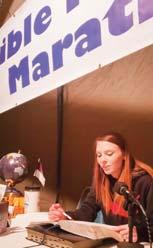
Church plant established: 1947 Southern District Conference Attendance: upper 40s
Lead Pastor: Jesse “J.E.” Wadkins
Our congregation in three words: Loving, engaging, joyful
How can you pray for us?
Pray that as believers, we will not be distracted by the busyness of life, the world and its cares.
Top of page: Church elders pray over and welcome new members during the Dec. 31, 2023, morning service.
Upper left: Seth, Paul, and Dustyn show off their grilling skills for a summer cookout held in the church's own beautiful backyard.
Bottom left: New member Christina is baptized in National Buffalo River. Christina successfully completed a one-year Christ-centered program for women coming out of addictions. Patricia Wilson, a pioneering member of Martin Box, and Pastor J. E. are teachers for this area program.
Bottom right: Martin Box, known locally as Martin Box Chapel, participates with other local churches in an annual Bible Reading Marathon broadcast on the grounds of the county courthouse. Pictured is Caisha Howell completing a 30-minute segment.
Compiled by Janae Rempel Shafer
Fifty-seven people gathered Jan. 810 at Copper Hills Community Church, Peoria, Ariz., for a by-invitation-only vision summit convened by USMB national director Don Morris and focused on the shortage of young leaders.
“This is a family gathering,” Morris said in the opening session. “We want to talk openly and kindly. We want to identify the problems we have and why. When we are finished, we want to have answered the question, where do we go from here.”
Morris worked with the USMB National Strategy Team to plan and host the summit that brought together selected pastors and leaders involved in leadership development. The event addressed three topics: generational and global trends that contribute to the shortage of young leaders, current church culture and U.S. Mennonite Brethren educational culture.
The format for each topic included a time of worship led by Copper Hills musicians, a short presentation by an USMB ministry leader, discussion and prayer guided by Jana Hildebrandt and Andy Owen, pastoral staff at Ridgepoint Church, Wichita, Kan.
A key component for each topic was discussion as table groups, assigned small groups and/or as a large group. In fact, the schedule set aside twice as much time for discussion as presentations. Groups discussed prepared questions that addressed challenges and barriers to leadership development and how these are being dealt with, what is and isn’t working in efforts to develop leaders and how Multiply, FPU and TC and denominational programs can be better used.
Daniel Rodriguez, Central District
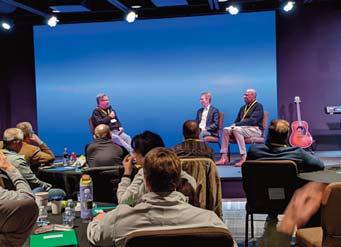
Conference minister, Jordan Ringhofer, Pacific District Conference minister, and Galen Wiest, Multiply director of mobilization, served as discussion leaders. Each moderator was paired with a secretary who recorded the group’s comments. Large group discussions were also recorded. Notes from the small and large group discussions were compiled and forwarded to the National Strategy Team.
Presenters were Kyle Goings, USMB NextGen chair, addressing generational and cultural trends; Joanna Chapa, Multiply mission mobilizer, speaking about global trends; and Wendell Loewen, Faith Front director and Tabor College faculty member, outlining church trends. Fresno Pacific University President André Stephens and Tabor College President David Janzen also spoke and participated in a question-and-
answer session moderated by Morris. Questions were pointed and, at times, confrontational.
The final session, moderated by USMB Leadership Board secretary Dave Thiessen, pastor at Mountain View Church, Fresno, Calif., was a brainstorming session. Participants offered more than a dozen suggestions for next steps. One idea that more than one attendee listed was to meet again this summer or in early 2025 and invite young leaders to attend.
The National Strategy Team (NST) planned the three-day event. In addition to Morris, Ringhofer, Rodriguez and Wiest, the National Strategy Team includes district ministers James Moore (Eastern), Aaron Hernandez (LAMB), and Tim Sullivan (Southern); and Jon Wiebe, MB Foundation president and CEO.—CL
Brian Harris has resigned as USMB church planting mobilizer to serve as the Southern District Conference minister, effective Jan.15. The Southern District announced Harris’ appointment in a Jan. 2 email.
Harris began serving as church planting mobilizer Aug. 1, 2022.
“Although Brian only worked for USMB as national church planting mobilizer for about 18 months, he made a strong impact through the building of regional MB church networks that are now primed for planting new MB churches,” says USMB National Director Don Morris. “Brian helped us realize that a church of any size can be involved in church planting.”
Harris worked alongside retiring minister Tim Sullivan during the first two weeks of the year.
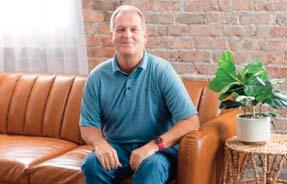
Southern District chair Jeremy Matlock says, “Filling this position and Tim’s shoes is no easy task, but God is good and sovereign. I believe he led us to the right man. Brian brings a lot of pastoral wisdom and encouragement that will benefit our pastors and churches well.”
Prior to his role with USMB, Harris pastored Pine Acres Church in Weatherford, Okla., from 2004 to 2022. He earned his bachelor’s degree from Moody Bible Institute and his master’s and doctorate degrees from Grace Theological Seminary. He and his wife, Stephanie, have two adult daughters. —SDC/USMB
USMB Gathering 2024 in Omaha, Neb., begins with the Pastors’ Conference July 23-25. Gary Hoag, sponsored by MB Foundation, will speak about biblically faithful leadership during four sessions.
As an optional add-on, MB Foundation will sponsor a free luncheon for pastors, spouses and families Thursday, July 25 from noon to 2 p.m.
After lunch, Brian Kluth, national spokesperson for National Association of Evangelical’s Financial Health and Bless Your Pastor programs, will be the speaker. Each attendee will receive a certificate for a $100 Amazon card ($200
per couple), and each pastoral couple will receive a $300 scholarship to attend a Weekend to Remember Marriage Retreat from NAE.
For more information, visit www.usmb.org/ usmbgathering2024.—USMB

Multiply, the North American MB global mission agency, has announced that “East of the Rockies” is the new name for the U.S. region that includes the Central, Eastern, LAMB and Southern District conferences.
“For a long time, Multiply's ‘Midwest region’ hasn't adequately described the area that includes the four USMB districts we serve,” says Stephen Humber, mission mobilizer. “We're glad to now be using a name that includes everyone.”
In addition to Humber, East of the Rockies personnel include Heidi Quiring, mission training mobilizer, Joanna Chapa, regional mobilizer, and Brielle Loewen, administrative assistant.
| Read longer versions of these and other articles at christianleadermag.com |
USMB NextGen is accepting applications from churches and individuals for Leadership Pipeline summer internships or residency programs. Leadership Pipeline assists in identifying, inspiring and investing in up-and-coming leaders through real-world experience and training.
For more information or to apply, visit www.leaderpipeline.net.—USMB NextGen
Registration for ASCENT, USMB NextGen’s annual national summer camp for Mennonite Brethren youth, opened Feb. 1.
ASCENT will be held June 8-12 at a new location, Camp W.O.W. in Stuart, Okla. USMB NextGen will offer a $50 per person travel subsidy for churches more than seven hours from Camp W.O.W. This subsidy is open to the first 100 people who register by April 1.
Early-bird registration prior to April 1 is $345 for students and $175 for adults. After April 1, prices will increase by $50. Any church with a youth worker who is part of the National Youth Worker Network prior to April 1 will receive one free youth leader ticket.
Author, coach and songwriter Justin McRoberts will serve as speaker. USMB NextGen Director Kyle Goings says McRoberts’ book Sacred Strides complements ASCENT’s theme of Rhythm.
“This year's theme is ‘Rhythm,’ and it's all about navigating those moments when life feels off-beat, out of sync and you're caught in an unfamiliar tempo,” says the promotional material. “This summer, we invite you to break free from the world's dissonant symphony and tune into a different rhythm—the rhythm of Jesus.”
The Wonderstate worship band from Minneapolis, Minn., will lead attendees in singing.
The schedule features sessions, free time and latenight activities, workshops and interactive tracks. Activities include tubing, high ropes course, human foosball, sand volleyball, rock climbing and waterfront activities.
For more information or to register, visit www.usmbnextgen.com/ ascent.—USMB NextGen

Beginning in fall 2024, Tabor College will again offer computer science as part of its catalog of more than 30 majors. The major was previously offered from 19832008.
The major is within the science and mathematics department and will require a new professor for the 2024 start date. Faculty members Ryan Calvert and Daniel Creamer, Al & Dotty Warkentine professor of mathematical studies, will assist in forming the program.

Designed around four concentrations, the program will range from 45 to 60 credit hours. The concentrations include software engineering, computer science, data science and bioinformatics.
The newly named major aligns with U.S. Bureau of Labor and Statistics data for the fastest-growing occupations and has ties to five of the top 15 occupations.
“Strong job prospects and earnings opportunities make computer science a very attractive major,” President David Janzen says. “Studying computer science in Tabor’s liberal arts and decidedly Christian context served me extremely well, and I am excited to reinvent the program with these creative and compelling concentrations.”
Through nine classes that will be added and the courses already in place, students will learn technical and communication skills for a rapidly growing field.—TC
Around 200 students and sponsors representing 10 churches gathered Jan. 27 at Community Bible Church in Olathe, Kan., for the Southern District Junior High Youth Conference (SDJHYC).
Tena Loewen, Parkview MB Church, Hillsboro, Kan., served as speaker. Andy Kinser led attendees in singing.
The schedule included two sessions, breakout groups, two workshop blocks and free-time activities. An offering was collected for the Lewis Family Mission in North Africa.—SDC
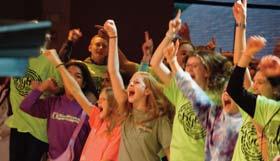
Fresno Pacific University and Reedley College have joined forces to improve opportunities for early childhood educators.
Students in Reedley College’s Early Childhood Education program can study for FPU’s bachelor’s degree in Early Childhood Development as part of a new cooperative program, where qualified Reedley students are guaranteed admission to the university and a 10 percent tuition discount. The university also helps students gain employment.
Participants progress from the associate program at Reedley into bachelor’s studies at FPU.
“The pathway between the two institutions allows the students to transition to the university level without feeling overwhelmed and nervous as they begin their next level of education,” says Cynthia Kaitfors-Smith, FPU faculty member.
Bachelor’s classes take place on Reedley’s campus in FPU’s degree completion format. Students meet one night a week in cohorts that stay together throughout an accelerated program for mutual learning and support. Students finish their bachelor’s degree in 18 months after a series of six-week classes.
FPU is also working to develop an A.A. to B.A. program with West Hills Coalinga: Firebaugh Campus. Both pacts build on similar pathways FPU has created with area K-12 school districts.—FPU.
Elton DaSilva, most recently the national director for the Canadian Conference of MB Churches, began serving Jan. 1, 2024, as the International Community of Mennonite Brethren (ICOMB) global director.
DaSilva, who has been a member of the ICOMB Executive Committee since 2023 and speaks multiple languages, has “strong spiritual leadership qualities, an impeccable reputation, a clear and aligned theological position and extensive familiarity with conferences in both the Global North and South,” writes Paul Dück, ICOMB chair, in a June 2023 email announcing DaSilva’s appointment. “Additionally, his ability to connect with additional resources will greatly aid in the expansion and consolidation of conferences.”

A rainy January morning gave farmer-florist Amy Ayers a break from her winter garden chores to sit down for an interview with the Christian Leader. Since 2018 Amy has been farming a plot on her parents’ Central California farm where she grows a glorious array of more than 100 kinds of flowers. She combines these blooms with cuttings from her own yard to create floral arrangements. Her creations range from petite jelly jar get-well bouquets to elaborate wedding displays. At Hope Kingsburg, her home church in Kingsburg, Calif., her flowers contribute to worship on Sunday mornings and grace the bedside tables of elderly shut-ins.
How did you become interested in growing flowers?
It’s definitely in my blood. Grandpa had a labyrinth of gladiolas and iris. He and Grandma loved to try that new seed in the catalog. When you grow up walking around a yard and talking with Grandma about the flowers, it’s just going to come. My plot is right where grandpa’s garden was in the old horse corral.
How do home-grown flowers compare with florist flowers?
There’s something different when you’ve done the whole process—planted and tended, harvested and arranged. It feels like a piece of my heart. Locally grown flowers are not perfect and uniform like the red roses in the grocery store. In fact, I like a crooked stem. In the gardener’s eye, if something grows really wrong, it’s more interesting to us than the perfect bloom.
How do you and the church partner together in your work?
I love calling people in the church about what is blooming in their yard and using their blooms to create arrangements for Easter and other church

events. And I like when people will call out of the blue to tell me, “I have this bush blooming.” There are faster and easier ways to get an arrangement done than going to someone’s house to visit with them and pick their blooms, but when you do those things it pulls other people into the idea of giving and can really bless their socks off.
What is your favorite season?
I love the dreaming, the seed shopping, creating a vision in my head for the coming year. Finding that new and interesting variety for the year is part of the thrill of the hunt.
What do you appreciate about the flowergrowing community?
Flower farmers are very visual people who enjoy color and form. We are always dreaming and pursuing the vision in our head. We’re growing something not just to get it to market, but to use, to give, to enjoy. There’s a lot of hope in flower farming, lots of anticipation before the reality hits and the gophers eat the carnations again. But there’s always next year…. That’s the hope part of it.
By Mark Isaac





Jesus calls us to be salt and light in the world

“
Hide it under a bushel? No! I’m gonna let it shine!” These lyrics are from one of the first songs I learned in church, “This Little Light of Mine”. And whether through sheer repetition, the work of the Holy Spirit or both, the meaning of these lyrics and the motivation to live them out stuck. I would never hide the light of Christ in my life or let Satan blow it out. Ever. I was going to shine the light till Jesus comes. Maybe you’ve sung this song with the same determination.
Jesus tells his followers: “You are the salt of the earth. But what good is salt if it has lost its flavor? Can you make it salty again? It will be thrown out and trampled underfoot as worthless. You are the light of the world—like a city on a hilltop that cannot be hidden. No one lights a lamp and then puts it under a basket. Instead, a lamp is placed on a stand, where it gives light to everyone in the house. In the same way, let your good deeds shine out for all to see, so that everyone will praise your heavenly Father” (Matt. 5:13-16, NLT).
Salt and light. Two very different substances, and yet both are used to make a singular point: The life of Christ within his followers is meant to have its intended effect on the world to produce praise to God.

As president of Tabor College in the early ‘80s, Vernon Janzen was also my professor. On his class reading list was Out of the Saltshaker and Into the World by Rebecca Manley-Pippert. The little Sunday school song had become a college assignment! I was being prompted once again to share my faith in Jesus wherever I went, particularly outside the “saltshaker” of the community of faith. As worthless as salt is that

has lost its saltiness, according to Jesus, salt left in the saltshaker will never fulfill its God-given properties or functions. It will not be good for anything.
It may seem far-fetched to us today, but salt was once used as a form of currency and had a significant and pivotal role in the formation of human civilization and the founding of cities. Wars were fought over and funded by salt. Agreements and alliances were forged with salt. And some of the earliest roads were built to transport salt.
Salt is essential to life. Humans and animals simply cannot survive without salt. How could such an essential substance ever be considered worthless? Only when it ceases to be salt, and that’s not possible.
Salt cannot lose its properties. Neither can light become something other than light. Salt will be salt. Light is light. If salt is kept in the saltshaker and not applied to food to preserve or flavor it, then what is it for? Salt has many other uses, but if it isn’t used for any of those purposes either, then what good is it? Similarly, if someone lights a candle only to place it under a basket where it will be extinguished, they have demonstrated they never intended to use the light in the first place.
These two substances cannot be anything but what they are. Jesus chose them to reveal the power and effectiveness of the transformation he makes in the lives of those who receive him. Why would we receive and follow Jesus if we only intend to live for ourselves? Such “faith” in Jesus is worthless, or as James writes, “Faith without works is dead” (James 2:26). “For we are God’s handiwork, created in Christ Jesus to do good works, which God prepared in advance for us to do” (Eph. 2:10).
Ready to be transformed
The salt and light to which Jesus refers is his presence within his disciples and his word lived out through their actions. It is the life they live “because of me,” Jesus says in Matthew 5:11. It is reflected by everyone who “hears these words of mine and puts them into practice” (Matt. 7:24). “By their fruit you will recognize them,” Jesus says, whether bad or good (Matt. 7:20).
Jesus’ use of such elemental substances, paired with such absurd actions, is arresting. Like the disciples who first heard him, we too must seriously consider his instruction. Are we ready to be transformed in substance by faith from what we are to what he has made us to be?
There is no going back from such a decision. Once we are made the salt of the earth, we will become salty. And once we are made the light of the world, we will
dispel darkness wherever we go. We will not be able to be or do otherwise.
During my younger years I hid the light and kept the salt to myself or within the boundaries of my life in church. I was afraid of what people “out there” would think of me if I shined too brightly for Jesus or rubbed non-believers the wrong way through my witnessing. I overcame those fears as I awoke to the reality that God was already “out there” in the world drawing people to himself.
He was not contained within the walls of the church, sending me and others out alone to do our best for him. No. God is alive and working in every place I might ever go and is inviting me to join him there, shining the light for all to see.
I learned that from Jesus, who in John 5:19 says, “I tell you the truth, the Son can do nothing by himself. He does only what he sees the Father doing. Whatever the Father does, the Son also does”(NLT).
Jesus lived his life with his eyes wide open to God’s presence and work in the world. As we step out of the church and into the world, we are not entering a “godless” place. God is already there, as Psalm 139:7-12 assures:
Where can I go from your Spirit?
Where can I flee from your presence? If I go up to the heavens, you are there; if I make my bed in the depths, you are there. If I rise on the wings of the dawn, if I settle on the far side of the sea, even there your hand will guide me, your right hand will hold me fast. If I say, “Surely the darkness will hide me and the light become night around me,” even the darkness will not be dark to you; the night will shine like the day, for darkness is as light to you.
In calling us to be salt and light to the world, Jesus is not asking us to do something God isn’t already doing and is doing still. We can step into the world expecting God’s presence and power to be operating there. We can look into the eyes of people we meet outside the church and see how the God who made them, loves them and is drawing them to himself. Then we can ask God how he would like us to join him in his work in their lives and let our little light shine!
Mark Isaac is lead pastor at New Life Community, Dinuba, Calif.

Althoughwords and signs were increasingly blurry, I didn’t realize I needed glasses until I had an eye exam. When the doctor gave me sample lenses to look through, I realized how fuzzy my vision was. When I got my own glasses, I was amazed at the clarity they provided. I could see the speed limit signs!
Something similar happens when we become followers of Christ. When we grow up in a culture, we don’t really question the way we see things. It’s not until we see Christ and begin to see life through Christ that we realize how fuzzy our cultural “vision” has been.


Do we see God and the world as Jesus does?
Christians sometimes call these new lenses a “Christian worldview.” By this they mean a new—and Christian—way of viewing and understanding the world. And in one way, this makes total sense. Before following Christ, we make sense of life via a set of cultural assumptions. Maybe this includes another religion or a mix of religions. Or perhaps it isn’t based on any religion at all—a “secular” viewpoint.
But when we start following Jesus and reading the Bible, we get new “lenses” by which to view the world, and we see it in new ways. In their book, An Introduction to Christian Worldview, Tawa Anderson et al suggest that these new “lenses” give us answers to four core questions: What is our world? What is our nature? What is our problem? What is our end?
Certainly, this can be helpful. But focusing on a “Christian worldview” also has some challenges. One is that, as Anderson points out, Christians quickly differ on some of the specifics of each answer. For instance, Christians certainly can agree on the big things, such as the presence of a God that created the world (answering the first question above). We may even agree on some common characteristics, such as the goodness of God. But we quickly start differing on the details. For instance, churches have long disagreed on how to square God’s goodness with the presence of evil. How does a good God allow for such evil in creation? It can be hard to decide what exactly is the Christian worldview.
A second challenge to the idea of a Christian worldview is that our “universal” worldview will always reflect some of our cultural ways of thinking. We can agree that God’s truth transcends culture, and there will come a time when, as Paul says, we will “see everything with perfect clarity.” But for now, we “see things imperfectly, like puzzling reflections in a mirror”
By Darren Duerksen
(1 Cor.13:12,NLT). Try as we might, our Christian worldview will always be influenced by the cultural ways we talk about and make sense of things.
A third challenge is that, as Philip Ryken says in Christian Worldview: A Student’s Guide, Christians can unfortunately “use the right worldview for the wrong reasons…hijacking the Christian faith for their social, political or ecclesiastical reasons.” Christians have used biblical principles to defend everything from medieval crusades to slavery, and we should have the humility to realize that we can be susceptible to the same tendency.
A “Jesus worldview”
It can certainly be helpful to think about a “Christian” worldview. However, because of these challenges and after living in and among various cultures and religions for many years, I am beginning to focus more on what I call a “Jesus worldview.” Whatever our differences, Christians can (hopefully) agree that we should do our best to view and live in the world via what our leader and Savior said and did. If this is the case, here are some questions—and possible answers—that a “Jesus worldview” might include.
How does Jesus relate to God? Undoubtedly Jesus, as the second person of the Trinity, has a unique relationship with God. And yet, he also sought to model for his disciples the ways they could view and relate to God. A Jesus worldview begins with the recognition that God is a God of truth.
What truths does Jesus highlight? A key truth is that we can know and relate to a God who loves and takes great joy in the people and work God has created. In The Divine Conspiracy, Dallas Willard says it like this: “Jesus’ good news about the kingdom can be an effective guide for our lives only if we share his view of the

world in which we live. To his eyes this is a Godbathed and God-permeated world…. It is a world that is inconceivably beautiful and good because of God and because God is always in it. It is a world in which God is continually at play and over which he constantly rejoices.” A Jesus worldview highlights a God who takes delight in us—all of us! A God who is close to everyone and invites us to be close to him.
How does Jesus relate to people? In his Sermon on the Mount, Jesus tells his disciples to be a light to the world. That they should stand apart from their culture and be a shining beacon of the good news. This isn’t a new idea to Jesus’ disciples. Everyone knows how the religious leaders of the day love to stand apart from others and to do so in the name of God. But it isn’t enough just to stand out. They need to do so for the right reasons.
What makes Jesus and his disciples stand out and be beacons for God’s kingdom? Interestingly, it isn’t their ability to defend the right beliefs. Rather, it is their love and care for others, particularly the poor, mournful, meek, vulnerable and overlooked of society. Jesus’ harshest criticisms are directed at Jewish leaders whose “worldviews” are closest to his, but who fail to love the people God loves. A Jesus worldview loves and cares for people in the way that God does, regardless of their ethnicity, status, etc.
How does Jesus relate to the world’s problems? Jesus and his disciples believe in the reality of sin. People commit sinful acts, even sinful thoughts, and need forgiveness. Many people in Jesus’ day were also guilty of the sin of not believing that Jesus was the Messiah (John 8:24). All this needed correction, confession and forgiveness. But Jesus does not
spend much time talking about sin per se. In the book of Matthew, for example, he uses the word itself only five times. But this doesn’t mean there weren’t deep problems in society. There was much that needed correcting.
The poor needed good news. The captives needed releasing. The blind needed sight. The oppressed needed freedom (Luke 4:18). Jesus healed spiritual brokenness, but also social, physical and emotional brokenness. A Jesus worldview sees sin and brokenness in all its forms and asks his disciples to consider how Jesus wants to bring God’s shalom to it.
For Jesus, where is everything headed? Certainly, Jesus has a view of life after death that is very different from other religions. He clearly does not believe in reincarnation, for example. He talks about a place of torment in the afterlife and of heaven (Luke 16:19-31). But as any student of the Bible knows, Jesus says very little about these things.
Jesus talks mostly about the coming of the kingdom of God; that it is arriving with him and extending on into the future of this world and the world to come (Luke 10:9; 13:29). Jesus is not, as the old adage goes, so heavenly minded that he is no earthly good. There is a big picture, but he is content and wants his disciples to be content. Jesus is content to let the far future and the afterlife remain a bit of a mystery. What he wants his disciples to focus on is bringing heaven to earth, now.
Conclusion
I long for “glasses” that help me make sense of all the issues and controversies in our culture. We all want a Christian worldview to help us. Unfortunately, what we’re given is often strangely similar to the latest versions of conservative theology, “ethical conclusions that I agree with” or American/Christian nationalism.
But Jesus never offers these kinds of glasses to his disciples. His glasses, the Jesus worldview, was and is a radical commitment to be like him and to see God and the world as he does. To move forward with the Bible and the Spirit in us and to love others and live faithfully in a world that needs Jesus, not the latest version of a Christian worldview.
Darren Duerksen is associate professor of intercultural and religious studies at Fresno Pacific Biblical Seminary.


By Natasha Crain
Itwas mid-morning on a weekday. The kids were at school, and I was working at my computer. I hadn’t had breakfast, and my stomach started rumbling. As my thoughts turned to food, I realized I needed to go grocery shopping. I started thinking about all the delicious things I would buy and the dinners I’d make. But first I had to eat something.
I heated up some leftovers and promptly experienced a food coma from the abundance of morning calories. When I sat back down at my computer, I audibly sighed and thought to myself, “I don’t want to go to the grocery store. I’m not even hungry now.”
I actually laughed out loud at the absurdity of my thoughts. What does hunger have to do with needing groceries at any given time? And why had I looked forward to everything I could buy just 30 minutes before, whereas now grocery shopping felt like a chore?
This seemingly trivial moment is such an appropriate analogy for the role of desire in a person’s spiritual life.
Why hope matters
Spend any time around Christians and you’ll hear about the “hope we have in Jesus.” But it occurred to me that day that we’re often trying to offer people—includ-
ing our kids—something they’re not even hungry for.
In order to hunger for hope, a person needs to first have a sense of hopelessness. As parents, we often see that our kids don’t seem to care as greatly about their faith as we would want. They embrace the hope in Jesus we keep giving them as much as you might embrace the hope of a cure for a disease you’re not too concerned about— lukewarmly and from a distance. And that brings me back to grocery shopping.
Objectively speaking, I knew I needed groceries that day, whether I was hungry or not. But I didn’t have the desire to shop because I wasn’t hungry for what I needed. Similarly, there’s a lot keeping kids in our culture full today, even if they’re Christians, and there’s a good chance they aren’t hungering for the hope of eternal life. Why?
Most of us have our basic needs of food and shelter met. We have the logistical luxury of getting almost anything we could want at the push of a button. We value material wealth and prioritize its pursuit. We glorify sports. We idolize entertainment. We’re consumed with social media.
In other words, we’re thoroughly distracted by what this life offers us. If the



things of this life don’t seem so bad to kids— and, on the flip side, seem quite enticing— why should they cling tightly to the hope of what happens after they die? They feel like they’ve got a pretty good thing going on right now.
This explains why we hear about kids dying with cancer who have a rock-solid faith many healthy adult Christians lack. And it explains why Christians in the world’s poorest countries often seem to express a joy and hope in Christ that is frequently missing in America. When people have had their earthly distractions removed—often without choice—they come face-to-face with the utter hopelessness of what the world has to offer.
They hunger for something more. And when their hunger is filled by the hope of eternal life with Jesus, there is joy where by all earthly appearances no joy should be found.
This realization left me with a parenting dilemma. I don’t want to force my kids into a desperate situation for them to hunger for hope, but I need to do a better job of helping them have a healthy sense of earthly hopelessness.
The hope of Easter
At Eastertime, perhaps more than any other time, we talk about the hope of Jesus. But if we want our kids to care about that hope, this is also the perfect season to talk about the hopelessness of the world. Here’s the lesson I want for my kids this Easter. In an atheistic worldview, there is no ultimate hope. If God doesn’t exist:
• Life is an accident with no objective meaning.
• We’re chemical specks in a vast, indifferent universe with no more inherent value than rocks.
• There’s little reason to believe we can freely make choices.
• No one should live in any particular way because it makes no moral difference.
• No one has a responsibility to anyone else because we’re just molecules in motion with no moral obligations.
• There’s no such thing as objective moral evil, so we can’t even condemn even the worst actions of society as objectively wrong.
• No one should want this to be true. But we should want our kids to understand just how hopeless such a world would be. If God doesn’t exist, then we experience enormous suffering during a crisis like the coronavirus, and that’s the end of the story. Large groups of molecules in motion (people) are



“
...when their hunger is filled by the hope of eternal life with Jesus, there is joy where by all earthly appearances no joy should be found. “
simply disintegrating into the Earth more quickly than we collectively expected.
Most kids have never thought through the logical implications of an atheistic worldview like this. In my experience, many atheists haven’t either. We need to draw the connections for them so they can fully appreciate what would be true if God wasn’t actually there: utter hopelessness.
Christian hope only matters if, and only if, Christianity is true. The last thing I would want my kids to think is that we are putting our hope in Jesus because an atheistic worldview is so bleak. Bleak things can be true things. We should never want to put our hope in Jesus simply because it makes us feel better. We should only put our hope in Jesus because there are good reasons to believe Christianity is true.
The truth test for Christianity is the resurrection. The previous point should lead us to ask how we would know if Christianity were true. In other words, we need to know what an appropriate truth test is.
Unfortunately, this is where many people go wrong today. They stop believing in Jesus because they haven’t experienced a certain answer to prayer, they haven’t experienced God in the way they’d like or any number of other reasons that have nothing to do with whether Christianity is true. The apostle Paul gives us the actual truth test for Christianity in
1 Corinthians 15:14: “If Christ has not been raised, then our preaching is in vain and your faith is in vain” (ESV).
The truth test is the resurrection. If Jesus wasn’t raised from the dead, we can pack our Christian bags and go home.
There is much evidence for the resurrection. I spent hundreds of hours in church growing up and never once heard any “evidence” for the resurrection. Based on what I hear from parents today, things haven’t changed much in most churches.
But if this is the ultimate test of truth for Christianity, and it’s the target of much mockery in our culture, it’s a tragedy that Christians overwhelmingly aren’t equipped to articulate why we have good reason to believe it’s true.
I’ve identified six questions every child should grow up being able to answer.
• Why does it matter if Jesus was resurrected?
• What historical evidence is there for Jesus’s resurrection?
• Was Jesus’s tomb really empty?
• Did Jesus’s disciples lie about the resurrection?
• Were Jesus’s disciples mistaken about the resurrection?
• Did people invent the resurrection many years later?
In my book, Talking with Your Kids About Jesus, I include six chapters explaining this evidence for parents to discuss with their kids.
Because Jesus was raised from the dead, we have meaningful hope that should change how we live our lives. If Jesus was raised from the dead—and we have every reason to believe he was—it validated that he was who he claimed to be (God himself). His resurrection confirms we can trust in his promises of eternal life—an eternal life where every tear will be wiped away, and suffering and death will be no more (Rev. 21:4).
That’s a hope worth hungering for. That’s a hope that should change how we see everything in this life, as long as we’re not full on the world.
One of the greatest gifts we can give our kids at Easter is a profound sense of earthly hopelessness. It’s a gift that will whet their appetites for hungering after Jesus the rest of their lives.
Speaker and author Natasha Crain is one of the USMB Gathering 2024 speakers. This article is reprinted by permission from her blog.



WhenU.S. Mennonite Brethren gather in July for Gathering 2024, “Salt & Light” will be the theme of the biennial event. In this issue, writers delve into Jesus’ statement in Matthew 5 that his disciples be useful, flavorful salt and bring praise to God by the light of their good deeds. In addition to the essays in the print magazine, two additional articles are available online only. Read these essays at www.christianleadermag.com
Not in the middle
Following Jesus does not mean we straddle the middle when it comes to the Culture War
How does Jesus’ response to the unclean woman in Mark 5 help us understand how we should approach living as a Christian in our world? By Tony Petersen
Being salt and light online
Three tips for being a healthy Christian online
When it comes to online behavior, many Christians often fall into the same traps as our non-Christian friends and neighbors. What if we, as devoted followers of Jesus, turned the tide with our online behavior? By Matt Ehresman
Could God’s love reach me?
Myspiritual journey has had many twists and turns. I have always been a seeker with a hunger for knowledge. My curiosity and eagerness for deeper understanding has led me down many adventurous roads.
I was born into a devout LDS family, and when I was in my teens, like many others raised in religion, I fell into the trap of rebellion. A pleasure-seeking lifestyle led me to a cycle of radical self-destructive behavior. I filled my life with drugs, alcohol and every form of immorality. I had no boundaries. No concept of right and wrong. I believed God existed in myself, and the only way I could really know God was to follow my own path of personal enlightenment. This self-centered pursuit only led to more questions, feelings of emptiness and ultimately, a life of anxiety and depression.
My life had come to a standstill when I got pregnant with my then boyfriend (now my wonderful husband). I was filled with so many doubts and fears about how I was going to raise this child. I realized that my life no longer revolved around myself. That’s when I met Jehovah’s Witnesses. They taught me that knowing God meant cleansing your life from all worldly influences and devoting all your time to evangelizing others. This felt familiar be-
cause of my upbringing in the Mormon church, and at the time I gravitated to their zeal and strong boundaries.
They further instilled in me what I was taught from childhood: that Christ’s atonement only applies when maintaining a strict standard of moral behavior. I became a Pharisee, looking down on my friends and family with judgment. The more I did to “serve” God only made me more prideful. I did not realize it was actually pushing me further away from Christ.
Once again, I found myself anxious and depressed. Even though I lived by the organization's standards, inwardly I felt like God’s love would never reach me because of my imperfections. I could never do all that was asked of me. I was exhausted.
When the pandemic hit, I was forced to pause and reflect on my life. I spent the time pondering and studying Scripture. The more I read, the hungrier I got and I realized that something was missing from my understanding of God. I wanted more depth to my Bible study, so I took to the internet and began devouring information about Christianity, which also led me to question my faith as a Jehovah’s Witness. Suddenly, I was confronted with a deep sense that I had been deceived. Christ’s love was much more profound than what I was told. Through my growing understanding, I felt Christ humbling me, teaching me what grace truly means. I cried out in my brokenness for God to show me the truth, and in that moment, I heard a voice saying, “I AM.” I knew it was
Jesus, revealing himself as one with the Father in purpose and essence. I felt the Holy Spirit rush into me, healing my broken heart and giving me clarity for the first time. At that moment all I could do was worship in full surrender. Since then, I began to see all my hard work at living a perfect life as a self-righteous attempt to become my own savior. Now I understand Jesus’ sacrifice was the only thing that was saving me from the judgment I deserved. I will never be “good enough” because there is no such thing. It is only through the mercy of God that I have been given the gift of forgiveness, and in my growing relationship with Christ I have experienced true transformation and freedom.

Rachel Amesquita attends Greenhouse Community Church in Saratoga Springs, Utah. She and her husband, Pablo, have two boys and a little girl on the way.
What small and healthy looks like
a small church that’s in the process of revitalization.
While there is much to say about church renewal, a major part of my learning recently has been on the subject of small churches and how my church can be healthy without ever becoming a “large” church.
Let me clarify two things right away: I am very thankful for big churches. I learned a ton working at Mountain View Church, Fresno, Calif., while in seminary. Big churches can reach people and accomplish things that smaller churches cannot. Second, healthy churches grow. No church should stay small out of laziness or stubbornness, failing to love the people God called them to.
That said, small churches can be healthy, and healthy churches can be small. This better be true, since half of U.S. churches are under 65 people. But what does small and healthy look like?
For starters, small churches are great at caring for people. We can’t avoid people, so it’s either love them or reject them. Healthy small churches are rockstars of “love per capita.”
This also means there are no cracks to fall through. We may not have a ministry for “your type” (kids, youth, singles, married, etc.) but we make up for it by ministering to you. When a
kid shows up, everyone’s on kids’ ministry. When somebody loses a loved one, everyone’s part of grief support. We minister personally to personal needs, not broad categories.
Another advantage is our agility. Sure, we can be stubborn and traditional, but when we do need to change, we can. At our annual meeting, three-quarters of the church showed up, and we fit around three tables. We can implement major changes immediately because everyone who's affected is part of the decision. Speaking of streamlining: my church used to be much bigger 50 years ago. When I came, we still had some structures from the big-church days, with a bulky leadership team and lots of designated positions. We even had a Nominating Committee to find qualified people for those positions — as if any of our 20 people had been overlooked! So, I raised the question: Do we try poorly to be a big church or be excellent at being a small church? We chose the latter and restructured our entire leadership to simply consist of those willing and trusted to lead.
We celebrated being a small church as part of an outreach event back in October. We called it Small Church Sunday, inspired by Small Business Saturday. It was just a normal church service but focused on inviting people to join us. We printed flyers for those we’d been meaning to invite for months, we had a pancake lunch afterward, and our sermon series in Matthew “happened” to line up with Jesus calling the disciples to follow
him. Our church, which had averaged 17 people at the time, had 50 people show up — triple our average! Sure, most of those haven't been back, but just as importantly, the long timers gained confidence inviting people to our tiny group.
I believe small churches are an essential part of the kingdom of God, and I hope more small churches realize their potential. If you'd like to join us and celebrate Small Church Sunday, we picked the third Sunday of October — and you're welcome to copy the logo!
Healthy small churches are rockstars of “love per capita.”

Alex Janzen is the lead pastor at Community Bible Church in Mountain Lake, Minn. He is a graduate of Fresno Pacific Biblical Seminary in Fresno, Calif., and Tabor College in Hillsboro, Kan.
“WeNEED your help!” was printed across the envelope, the fifth fundraising letter my household received that week. Every group that reached out said the same thing: Our organization requires more partners to ensure we can do the work.
With these consistent and important invitations to give, many of us are asking, “How do we, individually and corporately, decide which organizations to partner with?”
There is an overwhelming need for people’s time, talents and resources in our communities. This is not a new issue, and there is not a new response. We see evidence across Scripture of God’s direction to care for the orphan, the widow and the foreigner. God told his people then as now, “I command you to be openhanded toward your fellow [people] who are poor and needy in your land” (Deut. 15:11b). Jesus consistently lives this out in his ministry, caring for the sick, feeding the masses and spending time with outcasts.
Those of us following Jesus respond with a generous spirit, but knowing where or how to give requires further discernment. Jon Wiebe, president and CEO of MB Foundation, recommends that everyone “start with your heart” when answering the Holy Spirit’s call to generosity. Wiebe says, “Ask What has God made me uniquely interested in? What are
my spiritual values?” Jesus responds from a place of compassion, as opposed to obligation or guilt, and we are invited to prayerfully do the same.
There are many wonderful organizations for individuals to connect with, including our own faith communities. The majority of people I talked to give time and resources to their home church because they trust the stewardship practices of their congregation. Beyond that, the list of where people give varies—from local food banks to individual missionaries—with a preference to Christian groups. Why they decide to give is similar: people want to address a need they care about.
Churches take varied approaches to partnership. Some vote on where their community should give, others ask pastors or denominational leaders to provide direction. Some provide focused support to one organization for a season; others divide their gifts between multiple groups. Some put an emphasis on gathering financial gifts; others opt to collect supplies and others encourage volunteering time. One ministry leader I spoke with considers their church building to be their greatest gift, so their congregation is finding ways to donate meeting spaces to outside groups during the week.
Whether you are a household or part of a church board discerning who to partner with, Wiebe says that it is important to “check out their history, belief statements and faith alignment,” and cautions we “be suspicious of those unwilling to share financial data.” My own grandmother, Alice Farmer, reminded me how crucial that step is
and takes the time to research how her gift will be used. Sometimes wisdom looks like passing on or stepping out of partnership.
Lastly, wise giving requires communication. We don’t all agree on how partnership should look, which can create tension in our families and churches. I have attended budget meetings and missions updates where people’s ideas for giving conflicted. In these situations, Wiebe advises we “get everything on the table to hear clearly from each other.” Our church leaders should be equipped to navigate those conversations, and organizations like MB Foundation can provide help, too.
The Winter 2024 issue of MCC’s magazine, A Common Place, sums up our invitation well: “Can you help us help?” We give in different ways to different places but we can do it all with compassionate discernment.

Friesen, a graduate of Fresno Pacific Biblical Seminary, is married to Ben Friesen and is part of Cornerstone Community Church in Topeka, Kan.
Churches committed to growing disciples, meeting needs
Thissummer, U.S. Mennonite Brethren will meet in Omaha, Neb., for USMB Gathering 2024. The city of more than 487,000 is home to four Mennonite Brethren churches, which will be involved in hosting the event. These congregations, while small, share a commitment to being salt and light in their neighbors. They also embody the church planting strategy of churches planting churches.
The story of Mennonite Brethren churches in Omaha begins with Faith Bible Church. FBC was born from a Krimmer MB Conference mission ministry in northern Omaha in 1950. The church, originally called Fontanelle Chapel, moved to the Columbus Park neighborhood near downtown in 1968 and began meeting as Faith Bible Church.
“We (have) a specific focus of reaching the people in our urban context,” says pastor Stephen Stout, who has attended FBC for 32 years, including the past nine as pastor.
In 1985, Faith Bible planted Millard Bible Church. Five years later, FBC began a Spanish ministry, which became Iglesia Agua Viva, a daughter MB church officially established in 1994.
In 1996 FBC started a nonprofit, Good Neighbor Ministries, to better meet the needs of their neighborhood. This past December, FBC volunteers distributed gifts and shared the gospel with 120 neighbors.
The Faith Bible congregation of 50 hosts weekly Bible studies, a small group study and Truth Seekers, a Wednesday night children’s program that is growing. Sunday messages and small group studies
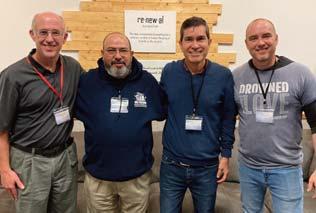
focus on discipleship. The first Sunday of every month, the congregation circles chairs for a family-style morning service including discussion, reflection and a meal.
Iglesia Agua Viva is the result of FBC and Central District church planting efforts. Led by Uruguayan missionary Walter Preza, the congregation first met at Faith Bible Church and was officially established in 1994.
Today, the IAV congregation numbers 90 and counting and is comprised primarily of first-generation Latino families from Mexico, Guatemala and El Salvador. The congregation also includes families from Honduras, Venezuela and Colombia.
Colombian missionary Rosemberg
Polania, his wife, Diana, and their two children came to Omaha about a year ago. After serving for 20 years in Latin American and Caribbean countries, Polania and his family moved to Omaha to serve as IAV pastor following Pastor Daniel Rodriguez’s appointment as the Central District Conference minister.
The congregation is passionate about reaching the less fortunate.
“Even though we are a church made up of immigrants with low economic resources, we want to be obedient to the calling of God to be merciful with the world that surrounds us,” Polania says. “We are a family of believers with the mission of equipping each other to love Jesus and live as those sent by him to this world.”
Once a month, the congregation
distributes hygiene and food items and a New Testament to homeless people. The congregation also provides preaching to homeless men at the Open Door Mission shelter. IAV assists Hispanic immigrants with finding jobs and housing and occasionally provides them with food, Bibles and a gospel message.
In 2010, Iglesia Agua Viva planted Iglesia Manantial de Agua Viva. Led by pastoral couple José Guerra and Yanira Lopez, Iglesia Manantial shares a building with Faith Bible Church and is comprised of members from Mexico, Guatemala and El Salvador.
Guerra has pastored the church since its beginning. The day before starting the church, Guerra and Lopez began a half-hour radio show on a local Spanish station. When the station closed, Guerra and Lopez began work on their own online radio station. In 2021, they began transmitting Radio Manantial de Dios with three live shows, which is still on air.
Guerra says the church’s biggest need is growth of membership—average attendance is 13—and the congregation is working on evangelism.
In August 2022, the congregation celebrated five students’ graduation from the Instituto Bíblico Anabautista (Anabaptist Bible Institute). Guerra and Lopez graduated from Seminario Bíblico Anabautista Hispano (Anabaptist Hispanic Biblical Seminary) in September that year.
Guerra is pursuing a graduate certificate in theological studies at Anabaptist Mennonite Biblical Seminary, a curriculum offered in partnership with Mennonite Education Agency Hispanic Ministries.
The Stony Brook Church congregation of 75 to 105 seeks to be a worshiping, relational and missional church devoted to the next generation.
“Our mission at Stony Brook is sim-
ple and complex: ‘Make Disciples,’” says church administrator Melissa Hanna. “Everything we do begins in prayer and leads directly back to our mission.”
Since September 2021, Jon Annin has pastored Stony Brook, which meets in the same building as Millard Bible Church, the USMB church he attended in his youth. Although Millard Bible closed in 2008, 10 years before it planted a church (Rolling Hills Church) that in turn planted Stony Brook in 2010.
Annin’s Sunday messages focus on the life of Jesus, while Growth Groups build community.
Ministries include serving foster-care families, the LIFT benevolent fund, community outreach and global missions.
Outreach events have included concerts, carnivals and movie nights. The congregation welcomed more than1,600 people to a Trunk or Treat event and 300 to a live nativity walk despite heavy rain. People donated more than 400 pounds of canned goods to a homeless shelter and provided Christmas gifts for more than 530 foster children.
“We enjoy coming together as a community of believers and creating fun and exciting ways for our community to feel comfortable and try stepping onto the grounds of a church in their area,” Annin says.
Stony Brook is participating in the Central District mentorship program with Annin and worship director Kristin Pikop mentoring Jude Johnson-Bohn, from Strawberry Lake Mennonite Church in Ogema, Minn.—Janae Rempel Shafer





duca er E
Master of Education in Neuroscience and Trauma
ind online pr of-a-k - e euroscienc
• One-of-a-kind online program can be completed in one year
ren ounded in cur ed y complet
• Grounded in current neuroscience and psychology research
esear chology r d psy
xamined thr sonalfaithise
ough esearch
• Personal faith is examined through the lens of neuroscience

rauma-I in T latest
oscience t neur en ear am can ogr Trauma tion ucation
visit tabor.edu/med
oscience .edu/med
• The latest in Trauma-Informed education
osciencneur or.edu/m r. ttab auma-Informed
Business agenda includes bylaw revision, budget vote, ICOMB update
Gathering 2024, the biennial National Pastors’ Conference, July 23-25, and National Convention, July 25-27, to be held at the DoubleTree Downtown in Omaha, Neb., will include the formal introduction of the new USMB national director, who was not yet announced at press time.
“Our hope is to have a qualified candidate in place by the convention where we will celebrate all God has done and where he is leading us as a national family," says Boris Borisov, Leadership Board vice chair.
Convention business is expected to include voting on a proposed national bylaw revision.
The Leadership Board, with the
U.S. Board of Faith and Life, has distributed a proposal to district leaders recommending removing the reversion clause from USMB’s bylaws, which would allow districts to address the handling of capital assets should a church withdraw from the conference or dissolve.
The current bylaw states that when churches withdraw or dissolve, their capital assets become the property of the district, but there has been a disparity between the bylaw and practice. The change would allow districts to address situations on a case-bycase basis. The board does not recommend that districts remove the reversion clause from district bylaws.
“Since a church joining is the
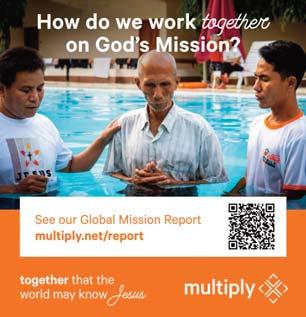
purview of the districts, we thought it best to have a church exiting also the purview of the districts,” says Leadership Board chair Luke Haidle.
Business will also include affirmation of the 2024 budget and an announcement pertaining to ICOMB USA’s organization and affiliation with USMB.
Five keynote speakers, including the new national director, will address the Gathering theme, “Salt and Light: Faithful Living in a Secular Culture.”
“Few other passages are as instrumental as Matthew 5:13-16 in understanding how we as Christians are to live in the world, called to be salt and light,” says USMB National Director Don Morris. “The convention planning team felt strongly that this was the message we needed to focus on for USMB Gathering 2024.”
Gary Hoag, president and CEO of Global Trust Partners, will speak about biblically faithful leadership at the pastors’ conference. Hoag is sponsored by MB Foundation.
Convention speakers are Brian Kluth, national spokesperson for the Financial Health and Bless Your Pastor programs of the National Association of Evangelicals, sponsored by MB Foundation; Natasha Crain, author and podcaster; and Don Morris, retiring national director.
Register for Gathering by May 1 to receive early bird pricing of $185 for the Pastors’ Conference and $235 for the National Convention. Registration rates for children are $99 for youth and $89 for children ages 212. Children 2 and under attend free. The hotel reservation deadline is July 1 to receive the group rate. For more information or to register, visit www.usmb.org/usmbgathering2024.
Janae Rempel Shafer
Formore than 50 years, Carrol Ediger has proofread the Christian Leader magazine, something the retired English teacher says comes naturally to her.
But after the Jan/Feb 2024 magazine, Ediger put down her proverbial red pen, concluding her tenure as an official CL proofreader. That doesn’t mean she’ll stop proofing anytime soon.
“It just comes automatically,” Ediger says. “I graded so many papers when I was an English teacher that I proofread about everything I read.”
Though a novice when she began proofing, Ediger’s career in English gave her credibility.
Ediger graduated from Hillsboro (Kan.) High School in 1953 and earned her secondary English degree from Tabor College in 1957. She taught one year each in Caldwell, Kan., and Okeene, Okla., before she and her husband, Ervin, bought a farm west of Hillsboro.
Once their three children were in school, Ediger went back to school, too, teaching high school English at her alma mater until 1992, where she had CL editors Don Ratzlaff and Connie Faber in class. She later earned her certification in library science and served as school librarian until her retirement in 2000.
Proofing the CL was something she could do on the side.
“There have been years, years ago, when the Leader was not known for being very accurate,” she says. “There were always a lot of errors in it, and it seems like when I got started, that was part of the reason they hired someone else to (proofread).”
Ediger, a member of Hillsboro (Kan.) MB Church, has proofread
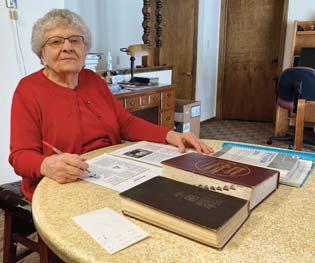
the Christian Leader for five editors: Orlando Harms, (1954-1976), Wally Kroeker (1976-1985), Don Ratzlaff (1985-1998), Carmen Andres (1998-2003) and Connie Faber (2004-present).
“Each editor had a different idea of what it was supposed to look like, and each editor had their own idiosyncrasies,” Ediger says. “But that wasn't my problem. All I had to do was keep proofreading.”
Over the years, Ediger also became familiar with various CL writers and their tendencies.
“I learned to know the different writers and what kinds of things to look for,” she says. “I try not to be too critical or think that I'm right
when maybe there's a possibility that I'm wrong. I trust my dictionary more than anything else.”
Ediger says while she has enjoyed proofreading the CL, it’s time to take off her official proofing glasses. Ediger’s family numbers 33, and she would like to have more time for family activities, she says.
And yes, she intends to keep reading and proofreading.
“When the papers come, I quit everything else and proofread,” she says. “I really enjoy proofreading, so I’ll keep proofreading, I just won’t do it for a business. Once your mind has that bent to look for things, you don’t get rid of it right away.”
Janae Rempel Shafer
Youth group volunteers assist with sports camp, Spring Spectacular
Whilestudents often anticipate spring break with excitement because it’s time off from their normal school schedule, parents may be looking for alternative activities to keep their kids occupied.
For the last few years, Mountain View Church in Fresno, Calif., has viewed the break as an opportunity to serve the communities neighboring both its main campus and Sunnyside campus.
The campuses, located about 5 miles apart, each offer a free event during the week of spring break to students from preschool age through sixth grade: a sports camp held at the Sunnyside campus and a “Spring Spectacular” day camp at the main campus.
The sports camp, which the church also offers during Thanksgiving break, began in 2021. Sunnyside was a mobile church plant for years before moving into a permanent building in the southeast Fresno area in January 2021.
“We were looking for ways to engage a community that doesn’t care about the fact that you’re in a building, and they’re not really interested in who you are as a church,” says Ken Wilkinson, campus pastor at Sunnyside.
It was also a challenge looking for proactive ways to bring people back to church after attendance declined dramatically because of the COVID19 pandemic.
“We wanted to offer something that was encouraging and engaging, especially for active boys, and also include a gospel presentation that is on their level,” Wilkinson says.
During the camp, which runs from 10 a.m. to 1 p.m., students are

grouped by age and move to different stations where they receive tutorials in football, soccer, basketball and baseball. They also hear a Bible story and enjoy a barbeque lunch before their parents pick them up.
“Part of the blessing of our four acres is that there’s a ton of grass, so we’re able to do everything outside, except the Bible story; we bring that inside to minimize distractions,” says Wilkinson.
He says they hear from parents and kids who look forward to each sports camp, and while the camp hasn’t led to a lot of church growth yet, they are “pressing into doing what God has put on our heart and trusting the Lord with the results.”
The Spring Spectacular was added to the spring break activities in 2022.
The day camp gives kids a glimpse of what a day at Mountain View’s
vacation Bible school, Summer Spectacular, is like. They enjoy several hours of games, crafts, worship and teaching, a skit and lunch.
John Leonard has been serving as the youth pastor at Mountain View for almost seven years, and 2024 will be his first year fully overseeing the event, which he has emceed in the past.
He explains that part of the inspiration for Spring Spectacular came from an event the youth group students have attended each spring break at another local church.
“Breakaway” is a three-day event hosted by Peoples Church in Fresno. Students in junior high and high school gather for services, games and worship in the evenings, and spend their days doing service projects in the city.
Leonard says it’s a way to get students excited about serving their local community. In the past, they’ve participated in park cleanups, helped at a food bank, worked with other ministry organizations and helped with cleanup at the church.
“Missions isn’t always going somewhere; it’s in our own backyard,” Leonard says. “We found that one of the needs was to reach families and kids when they’re on break to give them something to do.”
Leonard estimates that about 150 to 200 kids attended Spring Spectacular in 2023, which is about half of their usual summer VBS attendance. Twenty-two of those kids committed their lives to Jesus for the first time.
Mountain View gets the word out about both the sports camp and Spring Spectacular through local elementary schools.
“We partner with them at Christmastime to provide gifts for kids… and part of our working relationship
with the schools is then a couple times a year we’ll ask them to send out information,” Wilkinson says.
Adult volunteers from the church help with supervision and food preparation, but Wilkinson and Leonard both say the youth group students are essential to putting on the events.
“The only way we can do it is because students from the youth group make it happen,” Wilkinson says. “I come with a somewhat empty slate and say, ‘You know kids and you know the Bible, so I want you to think of a story to tell them and a way to challenge them to grow in their faith,’
and just leave that up to them.
“It’s the same with the sports areas—the students running the stations know more about their game than I do,” he adds. “The only guideline I gave them was, ‘Keep in mind the skill level of the people that you’re working with.’”
Leonard says, “We have youth who are eager to serve, and we want to allow them to thrive in that.”
This year, the Spring Spectacular will be held on the Monday of spring break, March 25, with the sports camp the following day.—Jessica Vix Allen


















Fairview church celebrates, recognizes those over 60
is in the air and with it the anticipation of prom. But for one Oklahoma church, senior prom is not a celebration for high school students but an event to recognize an older generation.
Each spring, deacons at Fairview (Okla.) MB Church host Senior Prom, formerly the Golden Age Banquet, to honor those in the church and community over the age of 60 with classy and fun dining, entertainment and fellowship.
To focus on their guests, Sheri Martens, a senior deacon, says each deacon couple is assigned a table to decorate in a spring or Easter theme and to sit at to get to know guests and make sure everyone feels included.
“Our purpose is to honor the senior citizens in the church and community by giving them a night they can come and be served,” Martens says. “We invite those who are still working, retired or are at the fellowship home and say, ‘If you feel you belong, please come.’”
Phil Eitzen, deacon chair, says they renamed the event in 2023 to try to engage younger seniors to attend. Though each year features various musicians, speakers or other entertainment and different menus prepared and served by the deacons, Eitzen says the purpose of the event remains the same.
“For over 40 years the deacon board has put on this event to honor the senior citizens in our community and give them a special night they can look forward to,” Eitzen says. “We bus guests back and forth from the fellowship home in town and invite seniors from outside our church to treat and honor them and share the Gospel.”
Elder chair Slim Unruh is one of
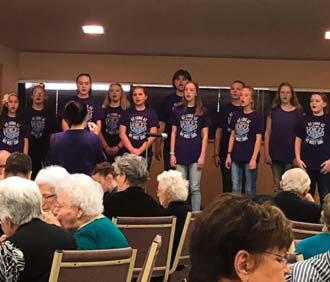
the 80 to 100 guests that usually attends the senior prom.
“It’s an encouragement to people to have an event to go to where they feel truly welcome,” Unruh says.
Terry Ratzlaff, former deacon, says in his years of serving and attending he has seen the senior prom be a means of impacting people.
“I’ve heard reports of it being the highlight of people’s year,” Ratzlaff says. “It really is a very special time that makes guests feel very loved and special and cared for. Having peers to meet and see again every year is like a family reunion and really does feel that way because of
the environment the church creates.”
As one might imagine, the guests are not the only ones impacted by senior prom.
“My wife used to say that when you give a hug, you’re also being blessed by a hug and that’s exactly how senior prom feels,” Ratzlaff says. “The deacons and church volunteers often end the night feeling like they are the ones who have been blessed not only to see guests who have come for years or the first time, but also to have the opportunity to be the hands and feet of Jesus and see him work.” —Caitlyn Decker
Scott Thomas began working Feb. 1 as church planting mobilizer
TheChurch Planting Council (CPC) announces that USMB has contracted with Scott Thomas as part-time church planting mobilizer. Thomas began this work Feb. 1, 2024.
Following the resignation of church planting mobilizer Brian Harris, who is now the Southern District Conference minister, the CPC began looking for the right person to take up the mantle of this crucial ministry.
“Scott Thomas adds value toward USMB’s continued effort in developing a culture of reaching the lost through church planting,” says Aaron Hernandez, CPC member and pastor of Grace Point Grulla in Texas. “His experience as a pastor and coaching pastors gives him current and accurate knowledge of how to best serve our churches.”
Thomas is currently the Lead Servant of Church Planting Partners and will continue with that work in addition to the new contracted role with USMB. Previously, Thomas served as president of Acts 29 for many years, has started three churches and was a lead pastor for 17 years. His pastoral ministry spans 42 years.
Thomas is now a “full-time missionary” to facilitate healthy pastors and healthy church planting. He is the author of The Gospel Shaped Leader, Gospel Coach Workbook, The Gospel Shaped Leader Workbook, Twenty Great Truths and Redeeming Grace. He is the founder of Gospel Coaching and co-author of Gospel Coach: Shepherding Leaders to Glorify God
Scott lives in Nashville, Tenn., with his wife of 41 years, Jeanne. They have two married sons and four grandchildren.
Some may remember Thomas from his time serving USMB church
planting from mid-2016 to 2018. He resigned that work because of his wife’s ongoing illness and the need to be home instead of on the road. His wife’s health has improved, and he now has freedom for travel as needed.
“Scott Thomas brings to the conference the experience and the passion that can propel us forward,” says Harris. “We are massively blessed to have his level of skill and experience in our family of churches.”
As church planting mobilizer, Thomas will provide regular one-onone coaching for all USMB church planters, cast vision and provide training for regional church networks and encourage “organic” church planting development. This includes collaborating with districts and networking MB churches for development of multiple church plant projects, while understanding the unique values, culture and realities of each district. In addition, he’ll provide “Church Planter Residency” groups for mutual encouragement, training and connection and will facilitate church planter assessments.
“What a privilege to stand shoulder to shoulder with the MB family, committed to fueling our church planters and pastors as they inject vitality into their congregations through multiplication,” Thomas says. “For our established churches, deeply anchored in our shared confession of faith, the call is clear: we have both the privilege and the profound duty to plant new MB churches with fresh vigor.”
USMB national director Don Morris says, “When Brian Harris resigned as church planting mobilizer, I and others began praying and asking God for someone with the right skill set to be able to step into this
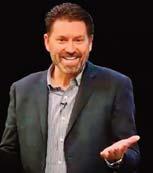
...we
have both the privilege and the profound duty to plant new MB churches with fresh vigor.
vital role. God has provided. Scott brings a wealth of experience, plus he knows our MB family well. He has great passion for church planting as a whole, and probably even greater fervor for coming alongside individual church planting couples to help them flourish. I’m delighted that Scott is joining our USMB church planting team. This is all about reaching more people with the gospel!” —USMB
Compiled by Janae Rempel Shafer
Baptism/Memberships
Jacob A. was baptized and received as a member at North Fresno (Calif.) Church Jan. 21. Chyanne Noble was also baptized, and Abe Friesen and Joyce Friesen were also received as members.
Alexandra Baier, Sarah Dean, Emily Gierisch, Brian Hamrick and Shellie Pardoe were baptized Jan. 14 at South Mountain Community Church, St. George (Utah) Campus. Jordan Costello, Cody Finsand, Haley Greb, Taylor Kelly, Kennedy Madsen, Juan Olvera, Noah Olvera, Susan Olvera, Kaylee Robinson, Tyler Thompson and Bella Torrey were baptized Dec. 10.
Twelve people were baptized and 22 were received as members at House of the Gospel, Fresno, Calif., in 2023.
Two people were baptized Dec. 31 at SouthLife Church, Wichita, Kan
Barbara Bennewitz, Dustyn Howell, Caisha Howell, Cameron Howell, Gunner Howell, Gabriel Howell, Emmi Howell, Harper Howell, Nick Cox, Isabella Cox, Luke Cox, Bradley Cox and Thelma Rea were received as members at Martin Box MB Church, Marshall, Ark., Dec. 31.
Tanner Boscomb, Karina Boscomb, Samson Barlow, Emma Barlow, Robert Staker, Sandra Osburn-Staker, Michael Garland, Michelle Haight, Luke Hare, Deacon Kendrick, Ryker Kendrick, Ben Mehrtens, Seth Mehrtens, Melodee Edwards, Brandy Kvenvold, Michael Kvenvold, Haley Mortensen, David Gilbreth and Mason Proctor were baptized Dec. 31 at South Mountain Community Church, South Jordan (Utah) Campus.
Katy Reinecker was baptized Dec. 10 at Zoar MB Church, Inman, Kan. Nash Burge was baptized Dec. 3.
Mark Isaac has resigned as lead pastor with New Life Community Dinuba, Calif.
Jim Holm retired as pastor at Butler Church, Fresno, Calif., at the end of January after 11 years of service in that role. Terry Brensinger began serving as interim congregational pastor Feb. 1.
Pastor Josh Gelatt was ordained during a Jan. 7 service at North Oak Community Church, Hays, Kan.
Joseph and Brianna Carter were installed Jan. 7 as youth pastor couple at Zoar MB Church, Inman, Kan.
Joe Gustafson began serving Jan. 1 as student ministries pastor at Bethany Church, Fresno, Calif.
James Friesen began serving Jan. 1 as family ministries pastor at Buhler (Kan.) MB Church.
Hall, Jazmin Elane, Shafter, Calif., Shafter MB Church, Dec. 31, 1990—Dec. 16, 2023. Parents: Steven Sr. and Kim (Braisher) Smith. Spouse: Jake Hall. Children: Jaycee and Jolene.
Hatton, David, Darby, N. C., member of Darby MB Church, Dec. 19, 1950—July 29, 2023. Parents: Samuel A.Y. and Lucille (Lipford) Hatton. Spouse: Sylvia (Maxwell) Hatton. Children: Bernessica Hatton and LaToya Ledbetter; 10 grandchildren and one great-grandchild.
Hein, Mary Helen, Fresno, Calif., member of North Fresno Church, Dec. 2, 1924—Dec. 3, 2023. Parents: Daniel A. and Anna Martens. Spouse: Marvin Hein (deceased). Children: Patricia, Penelope Hein-Unruh (both deceased), Holly Taylor; two grandchildren.
Hofer, Regina “Jennie” Rosella, Clovis, Calif., member of North Fresno (Calif.) Church, July 26, 1933—Dec. 25, 2023. Parents: Henry K. and Elizabeth (Boldt) Peters. Spouse: James William Gary (deceased), Jonas Hofer (deceased). Children: Nancy Ward, Marianne Madison; six grandchildren, 10 greatgrandchildren.
Hohm, Palmer D., Huron, S.D., member of Bethesda Church, Huron, April 16, 1936—Dec. 27, 2023. Parents: Edward and Elizabeth Hohm. Spouse: Barbara J. Hofer. Children: Barry, Laureen Taunton; six grandchildren, four great-grandchildren.
Isaak, George Henry, Sr., Reedley, Calif., member of New Life Community, Dinuba, Calif., June 13, 1937—Jan. 3, 2024. Parents: Henry Peter and Anna (Fast) Isaak. Spouse: Carol Isaak. Children: Kathy Hixson, Sharon Wall, George Henry Jr., Saundie; eight grandchildren, 12 great-grandchildren.
Jantzen, William “Bill,” Madera, Calif., member of Madera Avenue Bible Church, Madera, Dec. 23, 1933—June 23, 2023. Parents: William and Ann Jantzen. Spouse: Norma (deceased). Children: Tracy, Greg, Chris; five grandchildren, seven great-grandchildren.
Kliewer, John William, Jr., Weatherford, Okla., member of Pine Acres Church, Weatherford, June 18, 1955—Dec. 26, 2023. Parents: John William, Sr., and Lillie B. (Reimer) Kliewer. Spouse: Lorraine Schmidt. Children: Melissa McCoy, Kandice
(deceased), Kasey (deceased), Bradley; 10 grandchildren.
Koslowsky, Leona Ratzlaff, Hillsboro, Kan., member of Parkview MB Church, Hillsboro, Dec. 16, 1928—Jan. 12, 2024. Parents: Jacob and Marie Toews Leopp. Spouse: Allen Ratzlaff (deceased), Pete Koslowsky (deceased). Children: Kaye Bartel (deceased), Aleen, Don, Jone; Step-children: Ken, Janice Willems, Mel, Tom and Myrna Jost; six grandchildren; seven step-grandchildren; seven greatgrandchildren; five step-greatgrandchildren.
McClure, Virginia Lee, Madera, Calif., member of Madera Avenue Bible Church, Madera, Jan. 10, 1930—July 10, 2023. Parents: Robert and Gertie Duren. Spouse: Hubert McClure (deceased). Children: Elaine Ortega, Heath; four grandchildren, several greatgrandchildren.
Peters, Elda E., Henderson, Neb., member of Living Hope Church, Henderson, April 13, 1931—Jan. 2, 2024. Parents: John C. and Lena (Penner) Quiring. Spouse: Marvin Peters (deceased). Children: Linda Regier (deceased), Mike, Kevin Joe, Treva Uppal; seven grandchildren, five great-grandchildren.
Prentice, Robert Arthur, Wessington, S.D., Bethesda Church, Huron, S.D., April 18, 1958—Nov. 27, 2023. Parents: Robert and Ramona (Winegar) Prentice. Spouse: Vicki Ackerson. Children: Joshua, Tasha Roth, Micah (deceased); six grandchildren.
Radke, Dorothy “Darlene,” Ferndale, Wash., Good News Fellowship, Ferndale, July 30, 1933—Dec. 24, 2023. Parents: Gerrold and Ruth Patterson. Spouse: Elmer Radke (deceased). Children: Steve, Douglas (deceased), Gordon (deceased), Philip; 11grandchildren, numerous great-grandchildren.
Rollag, Megan, Freeman, S.D., Salem MB Church, Freeman, May 12, 2006—Dec. 2, 2023. Parents: Shane Rollag and Tabitha and Tyler Schoenwald.
Rusack, Judith, Wichita, Kan., member of Ridgepoint Church, Wichita, Jan. 13, 1944—Dec. 6, 2023. Parents: Earl and Anna McDaid. Spouse: Peter Rusack. Children: Chaplain Christopher, Kevin, Tracy Stark; eight grandchildren.
Suderman, Rubena Esther, Hillsboro, Kan., member of Ebenfeld MB Church, March 26, 1925—Dec. 25, 2023. Parents: D.J. and Tina (Reimer) Franz. Spouse: Leslie Suderman (deceased). Child: Lola Unruh (deceased); one grandchild.
Walker, Karen Ann, Ferndale, Wash., member of Good News Fellowship, Ferndale, June 21, 1950—Dec. 22, 2023. Parents: Jonas and Martha (Magner) Cornelsen and Merle Magner. Spouse: Larry Bartell (deceased), Bruce Walker. Children: Stephanie Rose, Shelly Pommer, Jeremy Bartell, David, Kara; 11 grandchildren.
Willems, Delbert Ben, Inman, Kan., member of Zoar MB Church, Inman, Sept. 28, 1938—Dec. 4, 2023. Parents: Ben and Mary Vogt Willems. Spouse: LaVonne Ediger. Children: Bonnie Wichert, Russ, Doug, Teri Tolle, Brad; 11 grandchildren, 30 greatgrandchildren.
Fresno, Calif., churches, including Mountain View Church, House of the Gospel, Butler Church and
Bethany Church committed to 21 days of prayer and fasting.
SouthLife Church, Wichita, Kan., held a game night Jan. 26.
Women from Reedley (Calif.) MB Church gathered for soup and swap Jan. 22.
Men from Axiom Church, Peoria, Ariz., had a potluck and game night Jan. 19. Women held for a meet-up Jan. 12 and an annual ornament exchange Dec. 5.
Bridge Bible Church, Bakersfield, Calif., women gathered for worship, teaching and fellowship Jan. 12.
Men from Buhler (Kan.) MB Church watched the college football national championship together Jan. 8.
The “Fully Alive” group for people 55 and over at Community Bible Church, Olathe, Kan., held a New Year’s Eve party Dec. 31.
Neighborhood Church, Visalia, Calif., partnered with Common Heart to offer a free coffee drink to people for three hours the morning of Dec. 26. The congregation celebrated a “Very Merry Sunday Funday” Dec. 17 with photos with Santa and Mrs. Claus, a train ride, slide, vendor village and more. They held a Flannels and Flapjacks event Dec. 3 with pancakes, family photos, a Buddy the Elf meet and greet, Christmas trivia and movie.
Pine Acres Church, Weatherford, Okla., held a pancake open house Dec. 31. The 8-Tracks group had Christmas Brunch Dec. 17.
Faith Bible Church, Omaha, Neb., hosted a worship and game night Dec. 31.
Living Hope Church, Henderson, Neb., hosted a New Year’s Eve brunch and devotional Dec. 31 and a senior pie social Dec. 12.
Bethel Church, Yale, S.D., served a Christmas breakfast Dec. 24. Women gathered for a program and fellowship Dec. 4. The congregation enjoyed treats, games, cookie decorating and carols Dec. 10.
The Cross Timbers Church, Edmond, Okla., congregation enjoyed cookies, hot chocolate and coffee Dec. 24.
Zoar MB Church, Inman, Kan., hosted “Cookie Cacophony” Dec. 31 and held its second annual “Snack-luck” (a potluck of snacks) Dec. 24. The congregation gathered for its Family Christmas Dec. 17 with stand-up comedy, skits, readings and music. Women held a freezer meals workshop and also did a cookie exchange and went Christmas caroling Dec. 10.
Valleyview Bible Church, Cimarron, Kan., held its annual Valentine Banquet Feb. 17. People went Christmas caroling Dec. 17.
Women from Copper Hills Church, Peoria, Ariz., gathered for worship, teaching and refreshments Dec. 16.
People from Lincoln Glen Church, San Jose, Calif., went caroling Dec. 15.
North Oak Community Church, Hays, Kan., held a Christmas talent show Dec. 17. Women did an ornament exchange Dec. 16. Seniors looked at Christmas lights and enjoyed cookies and cocoa Dec. 14.
Cornerstone Community Church, Topeka, Kan., held a Christmas party Dec. 13. People were invited to bring a hygiene item for Doorstep, which provides short-term assistance for people.
Women from Shafter (Calif.) MB Church gathered for quilt tying Jan. 19 and held a Bunco night Jan. 11. The congregation had a Christmas celebration Dec. 10 with a hayride, pop-up vendors, food trucks, bounce houses, crafts, face painting, photo opportunities, story time, games and an appearance by Santa Claus.
The deacon ministry team at Hillsboro (Kan.) MB Church hosted a Christmas luncheon for senior adults Dec. 10.
House of the Gospel, Fresno, Calif., organized a “Bowling with Dad” event Dec. 10.
New Beginnings, Ulysses, Kan., held a Thankmas dinner Dec. 10.
People from Ebenfeld MB Church, Hillsboro, Kan., went Christmas caroling Dec. 10.
Women from Bethany Church, Fresno, Calif., had a gift exchange Dec. 9.
Women from Kingwood Bible Church, Salem, Ore., gathered for a luncheon, games, devotional and prizes Dec. 3.
Ridgepoint Church, Wichita, Kan., hosted a “Thanksmas” potluck and gift exchange Dec. 2 and offered childcare for a parents’ night out.
Women from Good News Fellowship, Ferndale, Wash., gathered for a cookie exchange Dec. 16, and families went caroling.
Neighborhood Church, Visalia, Calif., held a night of worship Jan. 21 to sing, pray, reflect and focus.
Good News Fellowship, Ferndale, Wash., held a praise and prayer hymn sing Jan. 14 and 14 days of prayer and fasting Jan. 15-28.
People from Faith Bible Church and Iglesia Manantial de Agua Viva, Omaha, Neb., gathered for worship and prayer Dec. 31.
SouthLife Church, Wichita, Kan., launched a monthly worship and prayer night.
Salem MB Church, Freeman, S.D., celebrated the 80th birthday of its women’s ministry with a
party and meal Nov. 12, including encouraging people to dress in 1940s attire.
Redemption Church, Owatonna, Minn., celebrated its fifth birthday in September 2023.
South Mountain Community Church, Draper, Utah, celebrated its 25th anniversary in October 2023.
People from Neighborhood Church, Fresno, Calif., prayed for students and staff of Jackson Elementary Jan. 22.
People from Neighborhood Church, Visalia, Calif., donated clothing for the Neighborhood Degree Clothing Swap Jan. 20.
Women from Heritage Bible Church, Bakersfield, Calif., met for coffee and to tie knots to create blankets for a local shelter Dec. 16.
People from North Fresno (Calif.) Church purchased 68 gifts and distributed 38 food boxes for Christmas.
SouthLife Church, Wichita, Kan., sponsored three families for Christmas gifts through The Treehouse.
Ridgepoint Church, Wichita, Kan., raised $146,210.35 for its annual “Big Offering” to support the Jesus Loves Wichita project, HumanKind and LCC International University.
The Lincoln Glen Church, San Jose, Calif., congregation volunteered to help local nonprofits provide free meals during a drive through food distribution Dec. 23.
People from Pine Acres Church, Weatherford, Okla., provided food for the local police department Dec. 18.
People from Faith Bible Church, Omaha, Neb., went Christmas caroling Dec. 17.
Mountain View Church, Fresno, Calif., held a food and clothing giveaway Dec. 16.
The Cross Timbers Church, Edmond, Okla., congregation was invited to give toward a shower for the Hope Pregnancy Center Dec. 10.
People from Shafter (Calif.) MB Church went caroling for residents at Carrington Dec. 7.
Churches packed shoeboxes for Operation Christmas Child: Hillsboro (Kan.) MB Church (347 shoeboxes) and Fairview (Okla.) MB Church (289).
The North Fresno (Calif.) Church congregation donated items, gift cards and money for 38 relief kits for MCC.
The Shafter (Calif.) MB Church congregation donated $1,050 toward a new bus for Children to Love in India.
Parkview MB Church, Hillsboro, Kan., raised $835 during a December fundraiser for Embera Bead Project, a ministry that markets fair trade products that benefit indigenous people living in Colombia.
Faith Bible Church, Omaha, Neb., collected a special offering of $669.45 for Aaron’s Place in Zimbabwe with a matching offer.
Local Church
Lead Pastor: Lead Pastor: Valleyview Bible Church in Cimarron, Kan., is searching for a lead pastor. Please find more information at https://valleyviewbiblechurch.wordpress.com/pastoral-search/
Youth Pastor: Heritage Bible Church, Bakersfield, Calif., is seeking a full-time youth pastor/campus pastor. The church began Readyland Preschool in 1967. Today there are 300+ students on our church campus each day, from preschool through 8th grade. Primary responsibilities include: direct Junior High and High School ministries, train volunteer leaders and organize camps and mission trips. This person will also serve our school as a campus pastor, assisting in chapels and being available to teachers, classes and students for spiritual guidance. For a full job description, contact www.heritagebible.us.
Worship Director: North Fresno Church, Fresno, Calif., is seeking a part-time (20 hours/week) worship director. Qualifications: bachelor’s or master’s degree in music or Christian ministry and more than two years of full-time experience in worship and music ministry. For more information and to apply, visit https://northfresnochurch.org/jobs/ Email questions to office@northfresnochurch.org
Pastor of Student Ministries: Shafter (Calif.) MB Church is searching for a full-time pastor of student ministries to oversee junior high, high school and college ministries. Shafter is a community of approximately 20,000 located in the southern San Joaquin Valley of California, 10 miles northwest of Bakersfield. A full job description and additional information is available at https:// www.shaftermb.org/psm/



































